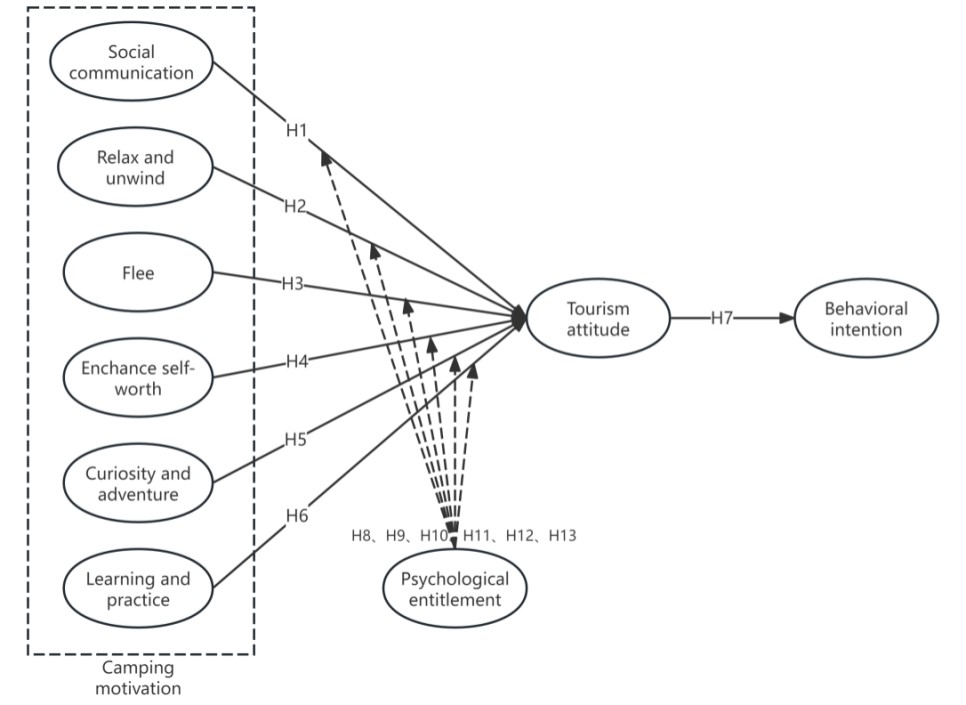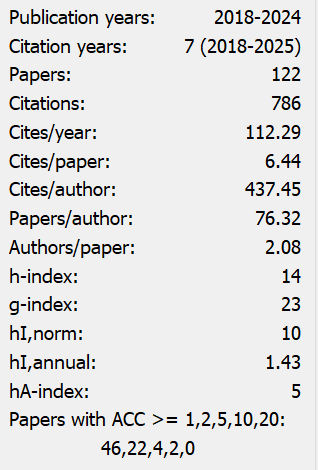A Study on the Relationship between Camping Motivation, Attitude, and Behavioral Intention
Abstract
This article uses 317 survey data of camping tourists to construct a structural equation model to test the impact mechanism of camping motivation on tourism attitudes and behavioral intentions, it tests the moderating role of psychological privilege on the relationship between camping motivation and tourism attitudes. Results indicate that, camping motivations, relaxation, social interaction, and enhancing self-worth, have significant positive impact on tourism attitudes, and the degree of impact decreases in order;The learning practice in camping motivation has a significant negative impact on tourism attitudes;Tourism attitude mediates the relationship between camping motivation and behavioral intention;Psychological privilege has a significant negative moderating effect on the path from relaxation and leisure motivation to tourism attitude.
References
Boyd III, H. C., & Helms, J. E. (2005). Consumer entitlement theory and measurement. Psychology & Marketing, 22(3), 271-286. https://doi.org/10.1002/mar.20058
Campbell, W. K., Bonacci, A. M., Shelton, J., Exline, J. J., & Bushman, B. J. (2004). Psychological Entitlement: Interpersonal Consequences and Validation of a Self-Report Measure. Journal of Personality Assessment, 83(1), 29–45. https://doi.org/10.1207/s15327752jpa8301_04
Chen, N., & Qiao, G. H. (2010). A comparative study on the tourism motivation of ecological tourists: A case of the geopark at the Mount Yuntai scenic spot. Progress in Geography, 29(8), 1005-1010. https://doi.org/10.11820/dlkxjz.2010.08.014
Chen, S. P., Han, X. Y., & Fang, S. J. (2023). Is more always better? The effect of customer engagement behavior on customer irrational behavior. Management Review, 35(3), 160-171. https://doi.org/10.14120/j.cnki.cn11-5057/f.2023.03.012
Crompton, J. L. (1979). Motivations for pleasure vacation. Annals of tourism research, 6(4), 408-424. https://doi.org/10.1016/0160-7383(79)90004-5
Devesa, M., Laguna, M., & Palacios, A. (2010). The role of motivation in visitor satisfaction: Empirical evidence in rural tourism. Tourism management, 31(4), 547-552. https://doi.org/10.1016/j.tourman.2009.06.006
Endah, P. E., Umar, N., Suharyono, S., & Andriani, K. (2017). Study on destination image, satisfaction, Trust and Behavioral Intention. Russian Journal of Agricultural and Socio-Economic Sciences, 61(1), 148-159.
Gong, B., Wu, X. Q., Han, H. (2011). Design and Construction of Ecological Landscape in Camping Are. Journal of Northwest Forestry Universit, 26(04), 231-235.
Grahammsd.(1981).Tourist motivation an appraisal.Annals of Tourism Research,2,187-219.
Juergen(1997). Tourism motivation and expectation formation. Annals of Tourism Research, 24(2): 283-304.
Li, F., & Wang, D. G. (2019). Influencing factors and mechanism of campgrounds development based on tourist online reviews: A case study of Suzhou Taihu RV camping park. Geography and Geo-Information Science, 35(2), 135-140. https://doi.org/10.3969/j.issn.1672-0504.2019.02.020
Li, X. S., Lai, M. S., & Tang, D. R. (2011). An empirical study on the influence of self-concept on rural tourism motivation: Based on the data from 319 Chongqing tourists. Tourism Forum, 4(6), 23-28. https://doi.org/10.15962/j.cnki.tourismforum.2011.06.007
Liang, J., & Wang, J. Y. (2013). Ecotourist motivation analysis based on structural equation model: A case study in Mao'er Mountain National Nature Reserve in Guangxi. Journal of Northwest Forestry University, 28(5), 227-233. https://doi.org/10.3969/j.issn.1000-176X.2011.12.024
Liu, H. X., Yang, Z. P., Wang, C. R., Han, F., Wang, Z. G. (2016). Camping Suitability of World Natural Heritage Based on GIS: A Case Study in Kurderning, A world Heritage in the Tianshan Mountains, Xinjiang. Arid Zone Research, 33(04):843-850. https://doi.org/10.13866/j.azr.2016.04.22
Liu Huaxian, Yang Zhaoping, Wang Cui Rong.(2016). Analysis of camping suitability for mountain natural heritage based on GIS, taking Kuerdening in Xinjiang Tianshan Heritage as an example.Research on Arid Areas,33(04):843-850.DOI:10.13866/j.azr.2016.04.22.
Luo Yanju.(2012). A study on the relationship between recreation impact perception and visitor experience in forest recreation areas [D]. Central South University of Forestry and Technology.
Rokeach, M. (1973). The nature of human values. Free press.
Shannon H, Susan A. Moore, Jim Macbeth(2015).Exploring the Motivations, Experiences and Meanings of Camping in National Parks,Leisure Sciences,37(3): 269–287.
Thurstone, L. L. (1928). Attitudes can be measured. American journal of Sociology, 33(4), 529-554. https://doi.org/10.1086/214483
Wang, D. S., Li, T. T., & Han, J. (2022). An exploration of how the crossover of time-honored brands impacts young consumers' brand attitudes. Management Review, 34(2), 203-214, 227. https://doi.org/10.14120/j.cnki.cn11-5057/f.2022.02.010
Xie, D. M., He, B., Cai, J. Y., Yang, X., & Guo, Q. (2020). Study on the influence of perceived risk of potential forest health tourists on behavior intention. Problems of Forestry Economics, 40(1), 66-71. https://doi.org/10.16832/j.cnki.1005-9709.2020.01.010
Xu, S. S. (2012). Study on the influence of rural tourism area image to tourists' behavior intention, master’s thesis of Zhejiang University.
Ye, J. M., Li, J. Y., & Li, L. (2020). Relationship among tourists' perceived value, place identity and behavior intention in grassland tourism. Journal of Arid Land Resources and Environment, 34(9), 202-208. https://doi.org/10.13448/j.cnki.jalre.2020.260
Zheng, C. H., & Zhang, J. (2024). A study of the dynamic decision-making mechanism among the tourists in public health emergencies from the collectivist perspective. Humanities & Social Sciences Journal of Hainan University, (4), 171-181. https://doi.org/10.15886/j.cnki.hnus.202208.008


This work is licensed under a Creative Commons Attribution 4.0 International License.
Copyright for this article is retained by the author(s), with first publication rights granted to the journal.
This is an open-access article distributed under the terms and conditions of the Creative Commons Attribution license (http://creativecommons.org/licenses/by/4.0/).


























